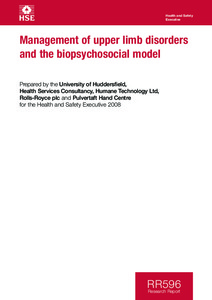Management of upper limb disorders and the biopsychosocial model
"This review, using a best evidence synthesis, examined the evidence on management strategies for work-relevant upper limb disorders and established the extent to which the biopsychosocial model can be applied. Articles were found through systematic searching of electronic databases together wi...
| Main Authors: | , , , , |
|---|---|
| Institution: | ETUI-European Trade Union Institute |
| Format: | TEXT |
| Language: | English |
| Published: |
Sudbury
2008
HSE Books |
| Subjects: | |
| Online Access: | https://www.labourline.org/KENTIKA-19188402124919066849-Management-of-upper-limb-disor.htm |
| _version_ | 1771659893451784193 |
|---|---|
| author | Burton, Kim A. Kendall, Nicholas A.S. Pearce, Brian G. Birrell, Lisa N. Bainbridge, L.C. |
| author_facet | Burton, Kim A. Kendall, Nicholas A.S. Pearce, Brian G. Birrell, Lisa N. Bainbridge, L.C. |
| collection | Library items |
| description | "This review, using a best evidence synthesis, examined the evidence on management strategies for work-relevant upper limb disorders and established the extent to which the biopsychosocial model can be applied. Articles were found through systematic searching of electronic databases together with citation tracking. Information from included articles was extracted into evidence tables. Themes were identified and the information synthesised into high level evidence statements, which were distilled into key messages. The main results are presented in thematic sections covering classification/diagnosis, epidemiology, associations/risks, and management/treatment, focusing on return to work and taking account of distinctions between non-specific complaints and specific diagnoses.
Neither medical treatment nor ergonomic workplace interventions alone offer an optimal solution; rather, multimodal interventions show considerable promise, particularly for vocational outcomes. Early return to work, or work retention, is an important goal for most cases and may be facilitated, where necessary, by transitional work arrangements. The emergent evidence indicates that successful management strategies require all the players to be onside and acting in a coordinated fashion; this requires engaging employers and workers to participate.
The biopsychosocial model applies: biological considerations should not be ignored, but it is psychosocial factors that are important for vocational and disability outcomes. Implementation of interventions that address the full range of psychosocial issues will require a cultural shift in the way the relationship between upper limb complaints and work is conceived and handled. A number of evidence-based messages emerged, which can contribute to the needed cultural shift." |
| format | TEXT |
| geographic | United Kingdom |
| id | 19188402124919066849_4b75e8a9aa4544dc99358368a67e1f6b |
| institution | ETUI-European Trade Union Institute |
| is_hierarchy_id | 19188402124919066849_4b75e8a9aa4544dc99358368a67e1f6b |
| is_hierarchy_title | Management of upper limb disorders and the biopsychosocial model |
| language | English |
| physical | 115 p. Paper Digital |
| publishDate | 2008 |
| publisher | Sudbury HSE Books |
| spellingShingle | Burton, Kim A. Kendall, Nicholas A.S. Pearce, Brian G. Birrell, Lisa N. Bainbridge, L.C. methodology musculoskeletal diseases psychosocial risks upper extremity disorders Management of upper limb disorders and the biopsychosocial model |
| thumbnail | https://www.labourline.org/Image_prev.jpg?Archive=116619193489 |
| title | Management of upper limb disorders and the biopsychosocial model |
| topic | methodology musculoskeletal diseases psychosocial risks upper extremity disorders |
| url | https://www.labourline.org/KENTIKA-19188402124919066849-Management-of-upper-limb-disor.htm |

